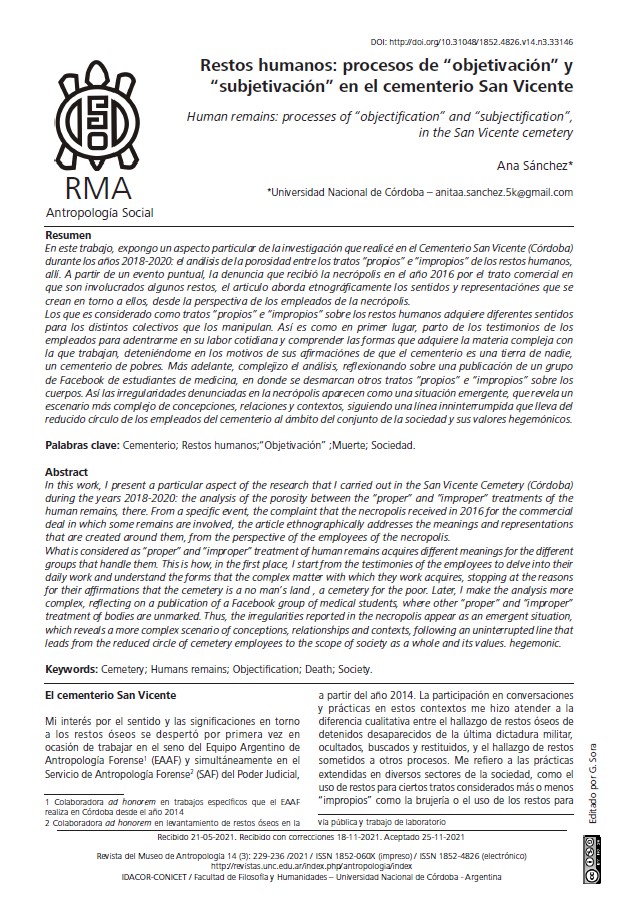Human remains: processes of “objectification” and “subjectification”, in the San Vicente cemetery
DOI:
https://doi.org/10.31048/1852.4826.v14.n3.33146Keywords:
Cemetery, Humans remains, Objectification, Death, SocietyAbstract
In this work, I present a particular aspect of the research that I carried out in the San Vicente Cemetery (Córdoba) during the years 2018-2020: the analysis of the porosity between the “proper” and “improper” treatments of the human remains, there. From a specific event, the complaint that the necropolis received in 2016 for the commercial deal in which some remains are involved, the article ethnographically addresses the meanings and representations that are created around them, from the perspective of the employees of the necropolis. What is considered as “proper” and “improper” treatment of human remains acquires different meanings for the different groups that handle them. This is how, in the first place, I start from the testimonies of the employees to delve into their daily work and understand the forms that the complex matter with which they work acquires, stopping at the reasons for their affirmations that the cemetery is a no man’s land , a cemetery for the poor. Later, I make the analysis more complex, reflecting on a publication of a Facebook group of medical students, where other “proper” and “improper” treatment of bodies are unmarked. Thus, the irregularities reported in the necropolis appear as an emergent situation, which reveals a more complex scenario of conceptions, relationships and contexts, following an uninterrupted line that leads from the reduced circle of cemetery employees to the scope of society as a whole and its values. hegemonic.
In this context, I investigate the reasons for the statement that the San Vicente Cemetery is considered a no man's land, a Cemetery for the poor. The fact that the existence of certain irregularities is reliably known is revealing of the representation that the State and society make of these sectors and of the behavior that they consequently adopt in relation to them.
Cemetery; Humans remains; Objectification; Death; Society
Downloads
References
Ariés, P, (1983) El hombre ante la muerte, Buenos Aires, Argentina, Taurus.
Barley, N (2000), Bailando sobre la tumba, Barcelona, España, Anagrama.
Biasutto, S (2018) “Situación de las universidades argentinas y latinoamericanas en relación al material cadavérico para la enseñanza de la anatomía” En Revista Argentina de Anatomía Clínica. Volumen 10 N° 2. Universidad Nacional de Córdoba. ISSN: 1852 8023. Disponible en: https://revistas.unc.edu.ar/index.php/anatclinar/article/view/20631
Carenzo, S (2017), “Desfetichizar para producir valor, refetichizar para producir el colectivo: cultura material en una cooperativa de – cartoneros – del gran Buenos Aires” en Horizontes Antropológicos, Puerto Alegre.
Dziuban, Z (2017): “Between Subjectification and Objectification: Theorizing Ashes”. En: Mapping the ‘Forensic Turn’: Engagements with Materialities of Mass Death in Holocaust Studies and Beyond, ed. Z. Dziuban (New Academic Press).
Hertz, R (1990) La muerte y la mano derecha, Madrid, España, Alianza Universidad.
Stevenson, R L (1884) “The Body Snatcher”. Pall Mall Gazette. Esocia.
Verdery, K (1999) Political life of dead bodies: Reburial and post-socialist Change. New York: Columbia University Press.

Downloads
Published
How to Cite
Issue
Section
License
Copyright (c) 2021 Ana Sánchez

This work is licensed under a Creative Commons Attribution-NonCommercial-ShareAlike 4.0 International License.
Those authors who have publications with this Journalaccept the following terms:
a. Authors will retain their copyrights and guarantee the journal the right of first publication of their work, which will be simultaneously subject to the Creative Commons Attribution License (Licencia de reconocimiento de Creative Commons) that allows third parties to share the work as long as its author and his first publication in this journal.
b. Authors may adopt other non-exclusive licensing agreements for the distribution of the version of the published work (eg, deposit it in an institutional electronic file or publish it in a monographic volume) provided that the initial publication in this journal is indicated.
c. Authors are allowed and recommended to disseminate their work on the Internet (eg in institutional telematic archives or on their website) before and during the submission process, which can lead to interesting exchanges and increase citations of the published work. (See The Effect of Open Access - El efecto del acceso abierto)











